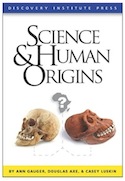 Evolution
Evolution
 Faith & Science
Faith & Science
Humanly Speaking
 There seems to be an idea on the part of some critics that my analysis in Science and Human Origins means that humans arose four million years ago. That is not the case.
There seems to be an idea on the part of some critics that my analysis in Science and Human Origins means that humans arose four million years ago. That is not the case.
In the book I said that we share four haplotypes with chimps, and between three and five haplotypes predate the putative split between our lineage and chimps, assuming common descent is true. How many haplotypes depends on how the tree is drawn, and where the estimated divergence time is placed.
Some have said mistakenly that this means the first humans must have appeared at four million years. I never said that and the data do not show that. The haplotypes show a mean age of 26 million years based on divergence between introns (three are very old, but two are recent — close to the time of our supposed split from chimps — thus the average age of 26 million). However, comparisons within lineages (or haplotypes) showed that over 90% of the allelic diversity within lineages arose within the last 180,000-320,000 years. This could be due to another bottleneck at the time of the emergence of Homo sapiens. Here is a quote from Bergstrom et al.:
Our intron analysis shows that most of the DRBI allelic lineages [haplotypes] predate the separation of hominoid species, consistent with previous analyses of coding and intron sequences. Within such ancestral lineages, however, the intron sequences are highly similar, implying that the HLA-DRBl alleles within lineages have been generated recently. The topology of the phylogenetic tree for intron sequences indicates that most of the alleles within lineages have been generated after the separation of Homo and Pan. The mean sequence difference among alleles within a lineage corresponds to an average age of 180,000-320,000 years (range based on the standard error). This implies that the vast majority (greater than 90%) of the more than 135 contemporary HLA-DRBl alleles have a very recent origin. The age of DRBl alleles estimated from intron sequences is quite different from the estimates based on exon-2 sequences, which proposed that a minority of the DRBl alleles have been generated after the separation of Homo and Pan.
To our critics, check the original data if you have doubts. There is further clarification as to why they think the low intra-allelic diversity is not due to selective sweeps or homogenization by recombination. Fascinating, isn’t it?
Cross-posted at Biologic Perspectives.
